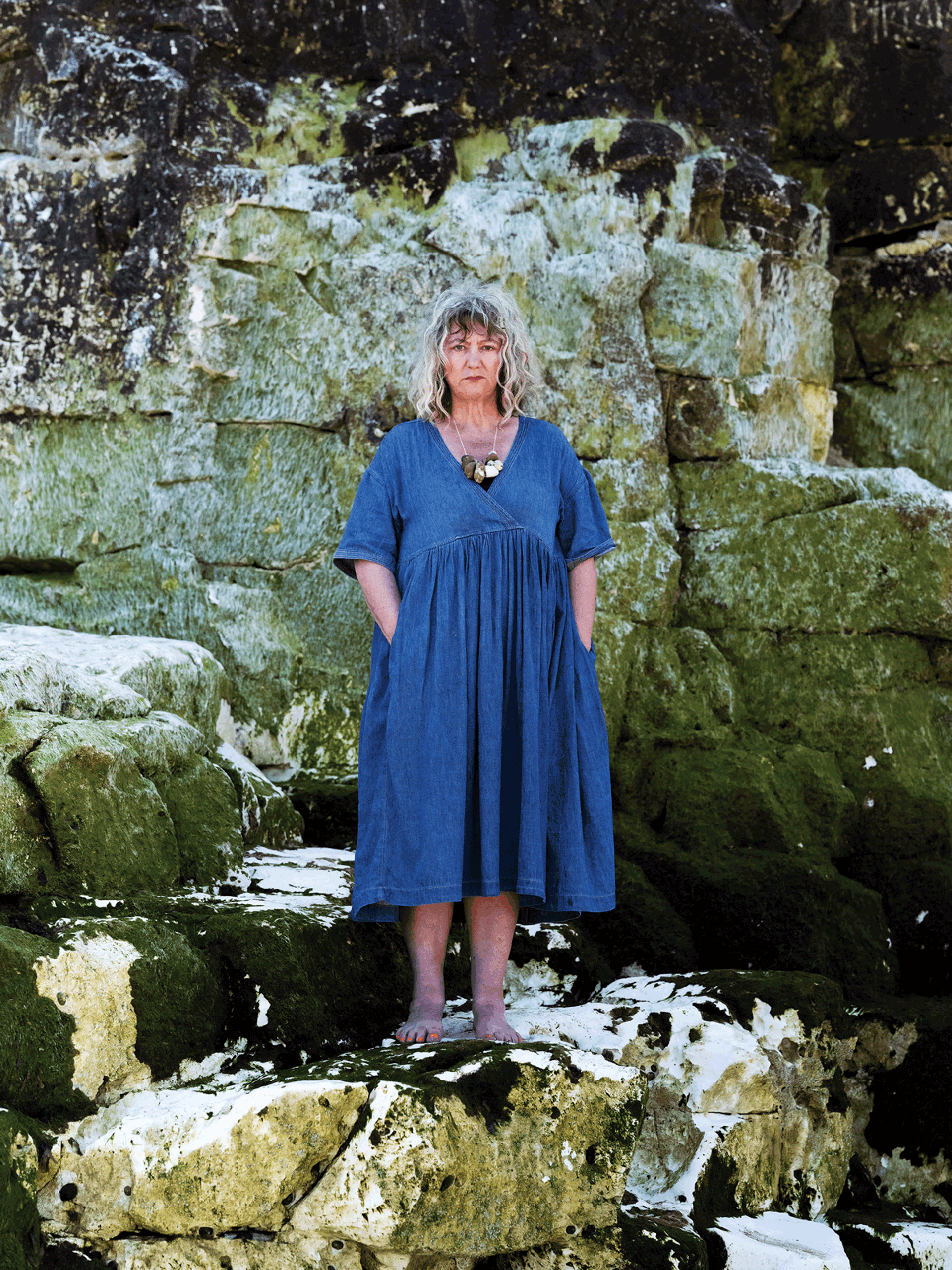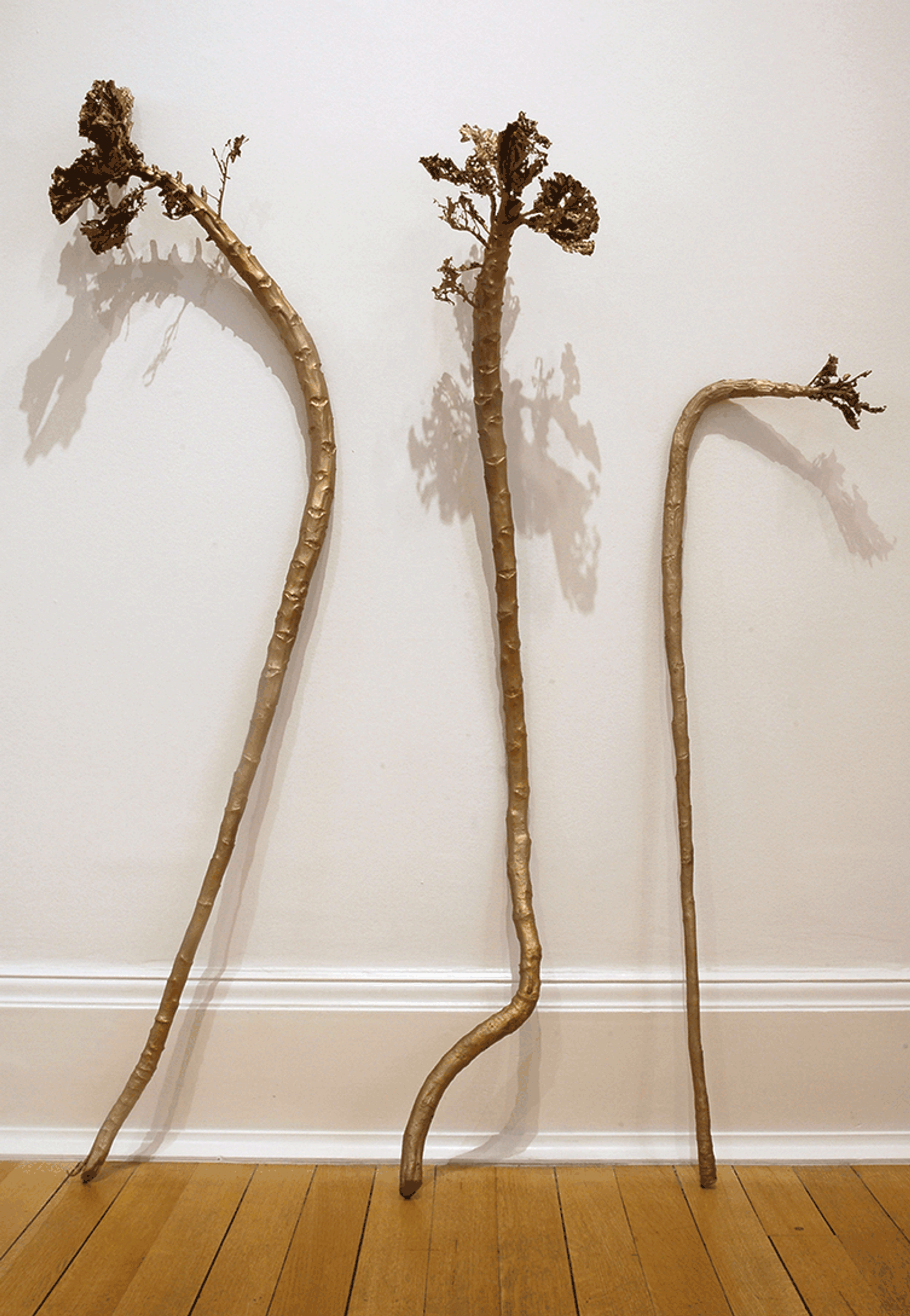For nearly four decades Anya Gallaccio has been making work from organic, unpredictable materials such as fruit, flowers, vegetables, ice, salt and chocolate—all of which can change, decay or even disappear over the course of a single exhibition. Sometimes the British artist further subverts art-historical conventions by casting in bronze such unlikely subjects as sprouting potatoes, broad bean pods and whole tree trunks to arrest any natural processes of transformation and create provocatively anti-monumental monuments.
Gallaccio’s art draws widely on the language and conventions of Minimalism, Arte Povera and Land Art while at the same time audaciously combining them with materials and methods more commonly associated with craft, agriculture, gardening or gastronomy.

Anya Gallaccio
Photo: Benjamin Eagle
This month, Gallaccio’s largest survey to date is opening at Turner Contemporary in Margate, Kent, and her 1994 installation Stroke, consisting of a room lined with chocolate, is being shown at Jupiter + in Paisley, the Scottish town where she was born. It was also recently announced that she has been commissioned by Aids Memory UK to create London’s first memorial to those affected by HIV/Aids, scheduled for completion in 2027.
The Art Newspaper: The title of your Turner Contemporary exhibition is preserve, an interesting choice of name given so much of your work is deliberately ephemeral.
Anya Gallaccio: It’s a loaded word with many layers. My first gerbera piece was called preserve ‘beauty’ but in this series of work the glass that covers the flowers ostensibly to protect them also accelerates their decomposition. So there’s a paradox, and for me it is always as much about setting a process in action and seeing what happens [as] illustrating a single idea. It’s harder now because I’ve worked with so many materials, but for a long time it was really important that I didn’t know the outcome. With “preserve” I was also thinking environmentally in terms of taking care of what’s around us and being aware of things. But not in the sense of preserving in a nostalgic way—for me it’s very important not to be thought of as Luddite or looking backwards.
Even when you work with more traditional materials like lead or bronze, there’s always a sense of impermanence and time passing.
I am interested in a degree of uncertainty and having a conversation with the material, although I have no expectations about how it will perform. Even when I’m working with “proper” sculpture materials, I’m still playing with that idea of permanence. I think about the bronze apple trees that I make as a kind of armature, to be strung with real apples so that the liquid that excretes from the fruit as it decays, patinates and affects the bronze. So there’s still a process going on, even if it’s not as obvious. Nothing stays the same.
“Preserve” also has culinary associations and many of your materials, such as flowers, fruit, vegetables and chocolate, are as much associated with the kitchen as with the artist’s studio, and can carry some old-school, gender-specific connotations.
When I started working with the flowers everyone said, no, you can’t work with flowers, you won’t be taken seriously as a woman artist! And I was like, well, fuck that. [Robert] Mapplethorpe can work with flowers and be taken seriously, but Georgia O’Keeffe, whose landscape paintings are spectacular, just becomes reduced to a notion of genitalia in terms of her flower painting.
So I used the logic of Minimalism to make work with flowers in a very unemotional, undemonstrative way. I wanted to see if I could make “serious” work using flowers. But I also wanted to disrupt the male language of Minimalism and its sense of authority and rationality by bringing in associations with the domestic or craft as well as by using materials that were unpredictable and unexpected, whether fruit, flowers or chocolate that would ooze, change and decay and resist the imposition of geometry.

The passing made permanent: Gallaccio cast Brussels sprouts in bronze for her 2007 work People Say Friends Don’t Destroy One Another—What Do They Know About Friends?
© Anya Gallaccio. Courtesy the artist and Thomas Dane Gallery
This friction between precision of form and unpredictable unruliness of material seems to run through so much of your work.
For me a lot of the history of art is about men imposing their will on, and—literally—mastering their materials. I may take on the formal devices of Minimalism—repetition, seriality, the grid—but the system then breaks down because the material is organic or has associations at odds with art history, whether repeated macrame knots or a hanging grid of supermarket apples. I am not in control and not a master of anything—I am an instigator.
Can you talk about your new commission for Turner Contemporary, which involves a gigantic custom-built 3D printer using a mixture of clay and chalk to build a positive image of local denehole caves.
Much of the work comes out of an initial inquiry that’s often a very superficial, knee-jerk response to a place. And in Kent, chalk is very conspicuous. There’s a seam of chalk that runs all the way under France, under the Channel, and then comes up through Kent and then runs northwards. I was thinking about place and time, how the land is made up, and how that impacts what people do. Now, with global warming the combination of climate and chalk means that French champagne houses are buying up land in Kent for vineyards. Then, of course, chalk is also an art material, associated with drawing, and you could say this machine is creating a three-dimensional drawing. The denehole is basically a 30ft shaft that was hand-excavated into these chambers, and so in a way what I’m now doing in this work is putting the chalk back into the hole.
You’ve also foregrounded Kent’s reputation as a major apple-growing county.
Kent and apples are synonymous, and I love that England’s national fruit collection is at Brogdale in Faversham. We could have done a whole show on apples; I can talk for days about all their different aspects. We think of them as natural English fruit but they are incredibly cultivated hybrids that came over with the Romans.
Because people are less interested in a range of apple tastes, and because of the need for long chill times, farmers are no longer planting different types of apples. So I’m planting an orchard on the Lees Court Estate [near Faversham], which will have at least 58 heritage trees that are more delicate, and each one has a story behind it. We’ve got a Decio, which is the oldest apple on record, dating back to the Roman times; a Flower of Kent, that is supposedly the variety that inspired Isaac Newton’s theory of gravity; and a Sops in Wine, which has red-coloured flesh. I see it as a sculpture but this orchard will remain as a living resource for schools. We’re working with teachers on a pilot cross-curricular project where you can teach maths, science, history, geography, literacy—all subjects—through the apple.
There is a prominent apple presence in your Turner Contemporary show.
I’m hanging apples on a bronze tree and also suspending a curtain of identical supermarket apples, where I’m thinking of all those art history still lifes, the apples of Matisse and Cézanne. Then at the end of the show we’ll collect all the pips and they will all be planted to make a crab apple hedge around the Lees Court orchard. During the run, I also want to have a special day like a country fair where people can bring in their apple pies and apple-related produce. I want it to be an optimistic show, even though everything’s falling to bits.
Earlier this year you won the commission for London’s first HIV/Aids memorial, and your proposal also features trees.
I am so proud to be doing this. I am of the same generation, and we were so affected by HIV and Aids. Basically the tree is felled, and the core is there, and the edge of the tree is there. But then there’s a huge ring taken out, which is stood up on its side. I’m thinking about time and the longevity of trees and how you can read time if you fell a tree, with that gap standing in for all the loss.
Will it be a specific kind of tree?
I don’t yet know what it will be. The plan is to make it out of a dark stone that will resemble rough bark on the outside but which can be polished on the inside edges so you can see your reflection. Carved into these shiny inside surfaces will be words including pronouns and non-specific descriptors like “mother”, “brother”, “sister”, “auntie”.

A detail of Gallaccio’s sculpture Time is our choice of how to love and why (russet) (2004)
© Anya Gallaccio. Courtesy the artist and Thomas Dane Gallery. Photo: Carlo Fei
Already growing along the edge of the land where the sculpture will be sited is a row of plane trees, which are often planted in cities because they can endure and survive pollution. I was thinking about them as a metaphor for people living with HIV and Aids. The majority of people currently living with HIV and Aids are women and girls from sub-Saharan Africa. Obviously, the memorial is acknowledging the people who we have lost, but it is also very much about people who are living. So these living trees seem to me like another symbol of resistance: whatever you throw at them, they keep going.
Biography
Born: 1963 Paisley, Scotland
Education: 1985 Kingston Polytechnic, 1988 Goldsmiths College, London
Lives and works: San Diego and London
Key shows:1988 Freeze, London; 1992 ICA London; 1999 Tramway, Glasgow; 2003 Ikon Gallery, Birmingham; 2008 Camden Arts Centre, London; 2015 Museum of Contemporary Art, San Diego; 2018 John Hansard Gallery, Southampton; 2019 National Galleries Scotland, Edinburgh
Represented by: Thomas Dane, Blum Gallery and Annet Gelink
• Anya Gallaccio: preserve, Turner Contemporary, Margate, 28 September-26 January 2025
• Anya Gallaccio: Stroke, Jupiter +, Paisley, 5 September-31 December


